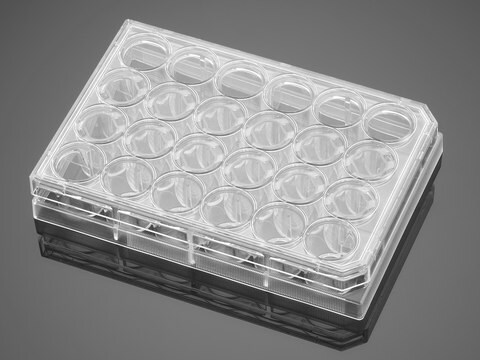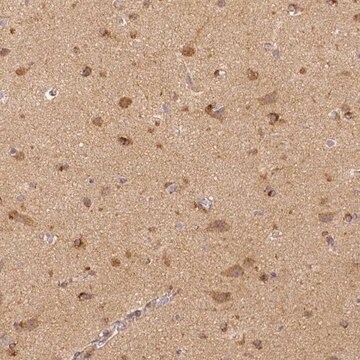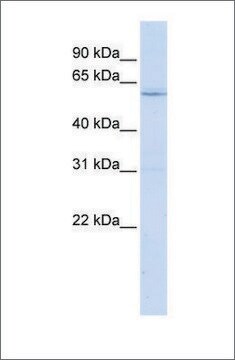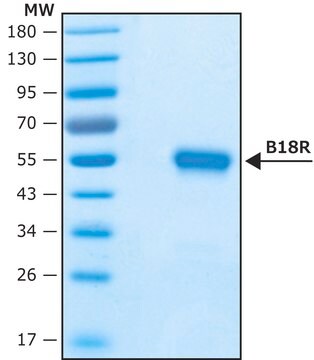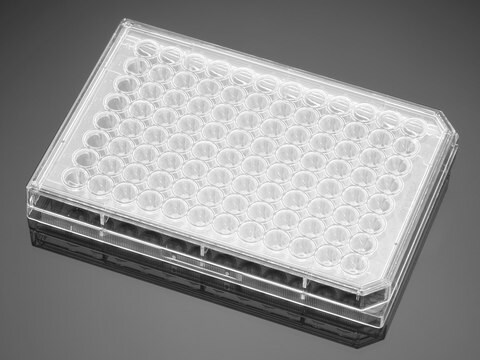Recommended Products
technique(s)
cell culture | stem cell: suitable
Quality Level
input
sample type induced pluripotent stem cell(s)
shipped in
ambient
General description
Various methods utilizing viruses, DNA, RNA, miRNA and protein have been developed to generate integration-free induced pluripotent stem cells (iPSCs). Disadvantages to existing methods include: (1) low reprogramming efficiency (i.e. DNA and protein), (2) a lengthy requirement for negative selection and subcloing steps to remove persistent traces of the virus (i.e. Sendai virus)1 and (3) daily transfections of cells using four synthetic mRNAs over a 14 day period (i.e. mRNA based).
EMD Millipore′s Simplicon® OKSG-cMyc RNA uses a safe and efficient method to generate integration- and virus-free human iPSCs using a single transfection step. The technology utilizes a single self-replicating Venezuelian equine encephalitis (VEE) RNA species that expresses reprogramming factors (RF) ORFs3. The Simplicon RNA replicon is a synthetic polycistronic VEE-RF RNA expressing five reprogramming factors (OKSG-cMyc; Oct4, Klf4, Sox2, Glis1 and cMyc), capable of self-replicating in a limited number of cell divisions. The 5-factor OKSG-cMyc Simplicon is especially useful for iPSCs generation from somatic cells that are more difficult to reprogram (i.e. slower proliferating cells or aged somatic cells).
EMD Millipore′s Simplicon® OKSG-cMyc RNA uses a safe and efficient method to generate integration- and virus-free human iPSCs using a single transfection step. The technology utilizes a single self-replicating Venezuelian equine encephalitis (VEE) RNA species that expresses reprogramming factors (RF) ORFs3. The Simplicon RNA replicon is a synthetic polycistronic VEE-RF RNA expressing five reprogramming factors (OKSG-cMyc; Oct4, Klf4, Sox2, Glis1 and cMyc), capable of self-replicating in a limited number of cell divisions. The 5-factor OKSG-cMyc Simplicon is especially useful for iPSCs generation from somatic cells that are more difficult to reprogram (i.e. slower proliferating cells or aged somatic cells).
Application
Advantages of the Simplicon® OKSG-cMyc RNA:
- Integration-free, footprint-free iPSCs generation. No risk of genomic integration.
- Safe, virus-free, synthetic polycistronic RNA replicon (all five reprogramming factors in a single RNA strand)
- Only one single transfection required. The RNA replicon is able to self-replicate, eliminating the need for additional daily transfections of multiple individual mRNAs over a 14-day period.
- Efficient and rapid reprogramming.
- No screening required to ensure the absence of viral remnants.
- Controlled elimination of synthetic VEE RNA replicon by the removal of B18R protein.
- Validated for reprogramming in feeder-free and feeder-based culture conditions.
Research Category
Stem Cell Research
Stem Cell Research
Components
1. VEE-OKSG-cMyc RNA: (Part No. CS221303) One (1) vial containing 10 L of RNA (1 ug/uL). Store at -80°C.
2. B18R-E3L RNA: (Part No. CS224503) One (1) vial containing 10 L of RNA (1 ug/uL). Store at -80°C.
2. B18R-E3L RNA: (Part No. CS224503) One (1) vial containing 10 L of RNA (1 ug/uL). Store at -80°C.
Quality
Tested to confirm the generation of iPS cells from p6 human foreskin fibroblasts. Other cell types have not been tested and thus similar results can not be guaranteed.
Storage and Stability
VEE-OKSG-cMyc and B18R RNAs: Stable for 4 months from date of receipt when stored appropriately at -80°C. For best recovery, quick-spin the vial after thawing on ice and prior to opening. Aliquot into sterile, nuclease-free eppendorf tubes on ice and store at -80°C. Limit repeated freeze-thaw cycles. Use in a sterile RNase-free environment.
Legal Information
SIMPLICON is a registered trademark of Merck KGaA, Darmstadt, Germany
Disclaimer
Unless otherwise stated in our catalog or other company documentation accompanying the product(s), our products are intended for research use only and are not to be used for any other purpose, which includes but is not limited to, unauthorized commercial uses, in vitro diagnostic uses, ex vivo or in vivo therapeutic uses or any type of consumption or application to humans or animals.
Storage Class Code
12 - Non Combustible Liquids
Flash Point(F)
Not applicable
Flash Point(C)
Not applicable
Certificates of Analysis (COA)
Search for Certificates of Analysis (COA) by entering the products Lot/Batch Number. Lot and Batch Numbers can be found on a product’s label following the words ‘Lot’ or ‘Batch’.
Already Own This Product?
Find documentation for the products that you have recently purchased in the Document Library.
Enhanced generation of iPSCs from older adult human cells by a syntheticfive-factor self-replicative RNA.
Naohisa Yoshioka
Testing null
Protocols
Stem cell reprogramming protocols to generate human induced pluripotent stem cells (iPSCs) including viral and non-viral RNA based methods.
Our team of scientists has experience in all areas of research including Life Science, Material Science, Chemical Synthesis, Chromatography, Analytical and many others.
Contact Technical Service
